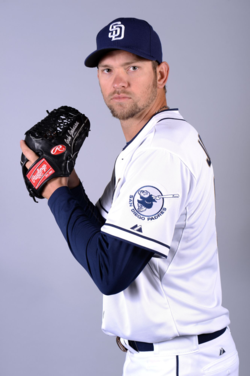The following 40-man roster players have less than five years service time and are out of minor league options. That means they must clear waivers before being sent to the minors, so the team would be at risk of losing them in attempting to do so. I've included players on multiyear deals. This list was compiled through MLBTR's sources. Our series concludes with the AL West.
Angels: Ernesto Frieri, Kevin Jepsen, Andrew Romine
Frieri is the team's closer, and Jepsen has a spot in the pen as well. About a week ago, Mike DiGiovanna of the L.A. Times noted that Angels manager Mike Scioscia said the team could open the season with an eight-man bullpen. DiGiovanna further explained, "Carrying an extra reliever and a five-man rotation would limit the Angels to a three-man bench consisting of a backup catcher, utility infielder and outfielder."
Romine is battling non-roster invitee John McDonald for that utility infielder job, though as MLB.com's Alden Gonzalez noted earlier this month, Grant Green appears to have joined the mix.
Astros: Chris Carter, Lucas Harrell, Raul Valdes
Carter will serve as the team's designated hitter. Harrell is looking to reclaim a spot in the Astros' rotation, which is something of an open competition behind Scott Feldman. Valdes, a lefty reliever, is the oldest player in Astros camp at age 36, according to Evan Drellich of the Houston Chronicle. He's competing for a lefty relief spot with Darin Downs and Kevin Chapman, wrote Drellich a week ago.
Athletics: Daric Barton, Josh Donaldson, Brandon Moss, Fernando Abad, Jesse Chavez, Chris Gimenez, Michael Taylor
Susan Slusser of the San Francisco Chronicle wrote about Taylor on Monday and Tuesday, noting that a scout told her a change of scenery might do some good for the 28-year-old outfielder. Slusser says non-roster invitee Sam Fuld is ahead of Taylor to potentially fill in for Craig Gentry if Gentry needs to start the season on the DL. Slusser wrote Monday that Barton will need at least a few more days to recover from a hamstring strain. Barton doesn't fit well at first base in a potential platoon with Moss, wrote John Hickey of the Mercury News in February, so it could be difficult for him to find a roster spot. Moss seems assured of semi-regular first base duty after hitting 51 home runs for the A's over the past two years. Donaldson is the team's starting third baseman after a breakout 2013.
Gimenez is seemingly fourth on the A's depth chart at catcher, so he has an uphill battle for a roster spot out of camp.
MLB.com's Chris Gabel wrote about Abad yesterday, noting that he's competing with Drew Pomeranz and Joe Savery to become the second lefty in Oakland's bullpen. Though Abad has surrendered a few runs in his six innings of spring work to date, Gabel quotes A's manager Bob Melvin as praising the 28-year-old, leading the writer to speculate that "he might already have secured a spot in the A's bullpen." Last week, MLB.com's Jane Lee wrote that Chavez "appears to be a lock" for the team's pen.
Mariners: Hector Noesi
The Mariners have an open rotation competition after Felix Hernandez in the wake of injuries to Hisashi Iwakuma and Taijuan Walker, wrote MLB.com's John Schlegel on Tuesday. James Paxton, Scott Baker, and Erasmo Ramirez might be the favorites, though, meaning Noesi is really competing for one spot. Noesi could instead be a long reliever out of the bullpen, Bob Dutton of the News Tribune suggested a week ago.
Rangers: Engel Beltre, Pedro Figueroa, Adam Rosales, Michael Kirkman
In a roster projection from Evan Grant of the Dallas Morning News today, he included both Beltre and Michael Choice, noting that the team doesn't want to lose Beltre. Keeping both Beltre and Choice might mean sending catcher Robinson Chirinos to Triple-A despite an impressive spring. Grant sees Rosales as the team's best backup infield option over Brent Lillibridge and Kevin Kouzmanoff, because Rosales can play second base, shortstop, and third base.
Kirkman is part of Grant's projected seven-man bullpen, while Figueroa is not. As a lefty who throws 95 miles per hour, Figueroa was intriguing enough to the Rangers for the club to claim him off waivers from the Rays in late January. It seems the Rangers will be forced to choose one of the two, barring a trade or injury.


